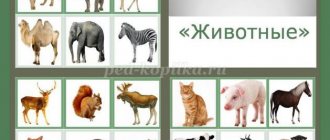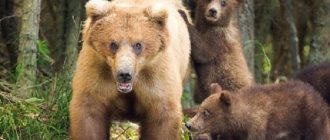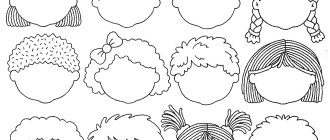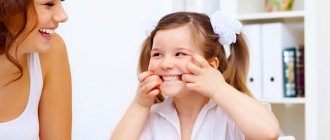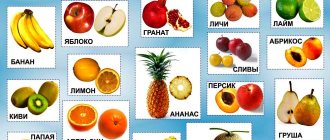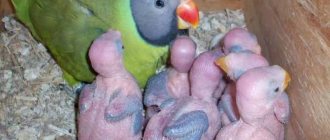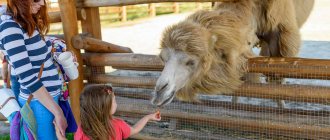Pictures of baby animals are our new lesson topic. Let's admire a pig, a calf, a lamb, a puppy and a newborn tiger together. We invite you to conduct an educational lesson with your child on a topic that he will definitely like. We will study which animal has which baby, and which baby has which mother! We have selected several different types of educational material on the topic “Animal Pictures”
Pictures of baby animals for children
- Cards with babies of various animals
- Cube with animals “Mom and baby”
- Arrow game "Mom and baby"
- Puzzles "Mom and baby"
- Pictures with animal families
Studying baby animals with a child
Spending a lot of time in an apartment, kindergarten or school, playing endless games on the computer, watching TV, our children are increasingly moving away from nature. Many children no longer know that the baby of a cow is called a calf, and the baby of a sheep is called a lamb.
Why does a modern urban child need this knowledge at all?
The child develops memory. In rare cases, people have a naturally good memory, but, basically, it develops only from constant practice, including practice with cards.
When you show your child cards and name the children of animals, you are talking about the animals themselves, about their children, about their way of life. This will expand the child’s understanding of the world around him and bring him a little closer to nature.
When you show your child cards and name the children of animals, you are talking about the animals themselves, about their children, about their way of life. This will expand the child’s understanding of the world around him and bring him a little closer to nature.
Please note how widespread the game “mothers and daughters” has become. Children are interested in learning everything about other small creatures, even if it is a puppy or kitten.
This system of relationships “parent and baby” is the stage of life that is now of greatest interest to your child because he is actively learning social roles. How to be a child? How to be a son or daughter? What does it mean to be a parent? The child actively absorbs all the information and, even now, while still a child, he is already beginning to learn to be a parent. These skills will be very useful to him in life, perhaps much more than the ability to subtract or read quickly.
When laying out pictures of animals for the first time, we explain to younger children that, like people, animals have families, each of which includes a father, mother and children. While shuffling the cards, we ask the kids to independently sort the animals into their families.
Then we invite the children to come up with stories about one of the animal families. This is a wonderful exercise for speech development.
With older children we introduce the concepts of “male”, “female”, “cub”. We learn the names of animals of different sexes and ages. We start with easy, single-root names: lion, lioness, lion cub. Let's move on to the next group: for example, ram, ewe, lamb.
General operating principles
If you want to get the maximum benefit from using visual material, then you need to follow several important rules:
- It is important to select images taking into account the age characteristics of the students. Children (up to 3 years old) need to be shown cards of domestic animals and birds only with those fauna inhabitants that the children can meet in person.
- The drawings should show real forest dwellers, animals of the seas and oceans, pets, and farm inhabitants. Avoid stylized images of wild animals and their domestic counterparts. The color of the coat and parts of the body should be natural, just like in nature. Not all children's pictures can be used in classes. For example, drawings of cartoon animals are completely inappropriate.
- It is important to choose images only with a light background, it does not distract attention.
- Cards with images should be attractive and durable enough. If you couldn’t buy good flashcards, you can glue the pictures onto cardboard yourself or laminate them.
Series of pictures “Domestic animals and their babies”:
Pictures with baby animals
Chick
Piglet
Calf
Duckling
Foal
Foal
Types of pictures
All cards for speech therapy classes can be divided into several groups.
Subject
Small cards, with one picture (an animal) on each. For example, in the series “Wild Animals of Our Forests” they will feature a wolf, an elk, and a badger.
“Animals of the North” set will consist of painted walruses, arctic foxes, and seals.
Plot
Illustration paintings with several characters and a plot. They help children write detailed, detailed stories using nouns, adjectives, and verbs. One plot picture allows you to discuss several topics at once: what benefits do pets bring, who cares for them, where they live.
brain teaser
A set of drawings depicting some kind of story, a plot in development. For example, some animals look different in winter and summer. An image of a squirrel in a gray and red coat, for example, allows a child to compose a story about the change of seasons and the preparation of animals for winter.
Drawings of wild animals and their cubs allow you to come up with a story about the childhood of a small animal.
Coloring pages
Outline images are another opportunity for the speech development of babies. High-quality coloring books help you master many new concepts and learn to use descriptive adjectives and prepositions. They also additionally stimulate the speech center (through regular fine motor skills training). Simple coloring pages can be used for children from 3 years old.
Coloring pages “Wild animals”
